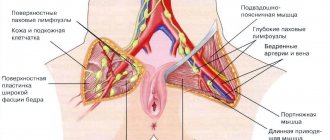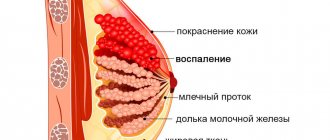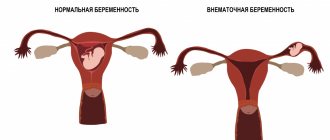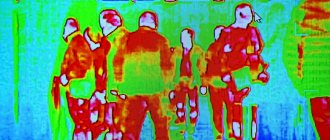Inflammation of the lymph nodes is most often a consequence of infection entering the body. In most cases, this symptom indicates the presence of pathology of certain organs. Inflammation of the lymph nodes in the neck, a symptom of which is their noticeable enlargement, is characterized by painful sensations in the affected area. The main purpose of this reaction is to prevent the spread of infection throughout the body.
In medical practice, this inflammation is called lymphadenitis. In the absence of timely, qualified treatment, it can develop into a separate disease. Subsequently, it leads to serious complications that pose a great danger to human life.
Causes of enlarged cervical lymph nodes
This group of lymph nodes drains the area of the head, neck, upper chest, and proximal parts of the upper extremities. Accordingly, enlarged cervical nodes most often indicate the presence of thyroid diseases, inflammatory processes in the oropharynx, bacterial and viral infections. The symptom is pathognomonic for rubella, develops with measles, and can be detected with more rare infectious pathologies - psittacosis, Ebola and Marburg fever, mycoplasma infections.
Thyroid cancer
Thyroid neoplasia accounts for about 1.5% of all malignant neoplasms and in most cases is asymptomatic. The most typical variant is papillary cancer. Follicular tumors are quite common. With these space-occupying formations, there is always an enlargement of the cervical lymph nodes, which indicates increased proliferation of malignant thyrocytes and metastasis of tumor cells. Typically, the lymph node remains soft and mobile for a long time, since the process does not affect the capsule and surrounding tissues.
Patients, as a rule, consult a doctor about an accidentally discovered nodule in the thyroid gland when it reaches 1 cm or more. As the tumor grows, other manifestations occur: cough, hoarseness, associated with compression of adjacent anatomical structures. Large tumors can compress the airways, causing shortness of breath and suffocation. When cancer spreads beyond the organ capsule, an expansion of the subcutaneous venous network and deformation of the contours of the neck occurs. In elderly patients, cachexia increases.
Cervical lymphadenopathy is one of the signs of thyroid lymphoma - an aggressive neoplasia characterized by intensive growth and involvement of neighboring organs in the pathological process. The disease often develops against the background of autoimmune thyroiditis. The tumor grows rapidly, occupying an entire lobe of the organ. Patients often themselves discover a node of woody density, which is combined with enlargement and hardening of the cervical lymph nodes on the affected side. Compression of surrounding tissues provokes dysphagia, paresis of the vocal cords, and displaces the esophagus and trachea.
Organic diseases of the thyroid gland
In other lesions of the endocrine gland, enlargement of the lymph nodes is caused by an increase in blood flow by 10-15 times, increased production and differentiation of normal lymphocytes in response to stimulation by foreign antigens. The size of the lymph nodes is more than 1 cm, they are elastic, not fused with the surrounding tissues, and are sometimes sensitive to palpation. The symptom is characteristic of acute inflammatory processes, but also occurs in benign neoplasms and chronic autoimmune thyroiditis. Cervical lymphadenopathy is caused by:
- Acute thyroiditis
. The disease begins suddenly with a sharp pain in the thyroid gland, which radiates to the lower jaw and ear. Lymph nodes enlarge on both sides, become very painful, and redness of the skin is noted. Purulent thyroiditis occurs with an increase in temperature to febrile levels and severe symptoms of intoxication. There may be complaints of a feeling of pressure and fullness in the neck, and increased symptoms when coughing. - Nodules and cysts.
According to statistics, various benign formations of the thyroid gland are detected in 10% of the population, but more often they are asymptomatic. Enlargement of lymph nodes in the cervical region occurs with inflammation or suppuration of cysts, hormonally active neoplasia. Lymph nodes are elastic, practically painless, the skin over them is not changed. A detailed clinical picture of thyroid damage is observed with overproduction of hormones - thyrotoxicosis.
Rubella and measles
Cervical lymphadenopathy involving the posterior cervical and occipital nodes is an important symptom of rubella. Lymph nodes are moderately enlarged in size, painless, and not fused to the surrounding skin. For children, the appearance of “bullet” lymph nodes is typical - multiple small formations in the neck. Simultaneously with lymphadenopathy, a rash occurs - pinpoint or papular rashes are localized on the extensor surfaces of the limbs, in the torso and head. The rash disappears after a few days, leaving no peeling or pigmentation.
Lymphadenitis with enlargement of the cervical lymph nodes develops in the catarrhal stage of measles. Lymphadenopathy is combined with rhinitis, conjunctivitis, hyperemia of the pharynx and puffiness of the face. In adults, the manifestations of the catarrhal period are less pronounced. A pathognomonic sign of measles is Belsky-Filatov-Koplik spots on the mucous membrane of the cheeks. After 4-5 days, the second wave of fever begins, which coincides with the appearance of a maculopapular rash. On the 1st day, the rash is located on the face and neck, by the end of the first day it spreads to the torso, and on the third day the rash spreads to the limbs.
Other infectious diseases
Cervical lymphadenopathy is detected in various infections occurring in the oral cavity and ENT organs. Symptoms may occur with systemic bacterial and protozoal lesions - anginal-bubonic form of tularemia, sleeping sickness, diphtheria. Enlargement of lymph nodes is associated with the primary penetration and proliferation of pathogenic microorganisms, intensive proliferation and accumulation of specific clones of lymphocytes in the follicular and paracortical zones. With damage to the cervical lymphoid formations, the following occurs:
- Congenital listeriosis
. Infectious pathology develops during transplacental or intrapartum infection of the child and manifests itself in the first days after birth. Damage to the cervical nodes is combined with febrile body temperature, roseola or hemorrhagic rash, granulomas on the oral mucosa. The late form is accompanied by muscle tremors, convulsions, enlargement of the liver and spleen. - Syphilis
. After entering the body, Treponema pallidum multiplies in regional lymph nodes, causing them to enlarge. Cervical lymphadenopathy is often observed when the pathogen penetrates through the mucous membrane of the oral cavity or lips, where the primary affect is localized - chancroid. A month later, the chancre disappears on its own, then a polymorphic rash appears, which indicates the generalization of the infection and the development of secondary syphilis. - Brucellosis
. In the prodromal period, patients complain of myalgia, arthralgia, and headaches. Then a fever occurs, lasting from several days to 3 weeks and alternating with heavy sweats. At high temperatures, there is facial hyperemia, enlargement of the cervical and axillary lymph nodes, which can be painful on palpation. In the acute form, small fibrous formations appear along the tendons. - Inguinal lymphogranulomatosis
. Enlargement of the lymph nodes of the neck and submandibular region is observed in the secondary period when the primary affect (ulcer) is localized in the mucous membrane of the mouth and pharynx. As the disease progresses, lymphoid formations turn into large-lumpy tumors and lose mobility. Subsequently, the nodes suppurate, fever and intoxication develop, and fistulas form. - Tonsillitis, pharyngitis
. The reaction of the cervical lymph nodes is detected in tonsillitis, which is due to increased antigenic stimulation of lymphoid formations. The symptom is accompanied by sore throat, redness of the throat and tonsils, and fever. You may notice yellowish dots or widespread plaque on the surface of the tonsils. Enlarged lymph nodes are also found in herpetic pharyngitis, which is characterized by a vesicular rash on the pharyngeal mucosa.
Severe cases of tonsillitis can be complicated by a retropharyngeal abscess, a purulent inflammation of the pharyngeal tissue. In addition to lymphadenopathy of the upper cervical and occipital lymph nodes, the patient is bothered by sharp pain in the throat, difficulty swallowing, and if the abscess is large, breathing disorders are possible. The general condition is disturbed, body temperature rises to 39-40° C. Enlarged lymph nodes, combined with damage to the jugular vein and septicemia, are pathognomonic for Lemierre's syndrome. In children, cervical lymphadenopathy often indicates adenoiditis.
Head and neck tumors
Lymph from the face and neck goes directly to the cervical lymph nodes, therefore, for various malignant tumors of this area, they are a typical site of metastasis. Lymph nodes are usually woody in density, tightly connected to the skin and surrounding tissue, and are not painful. Lymphadenopathy in certain types of tumors serves as the initial sign of the disease, when the primary tumor does not yet cause clinical symptoms. Enlarged lymph nodes are observed with such malignant neoplasias as:
- Neoplasms of the jaws.
The tumor may be characterized by exophytic growth with the formation of a protruding node with ulcerations. It may occur as a long-term non-healing ulcer with purulent discharge. Bone damage (osteosarcoma) is indicated by shooting pains, loosening and loss of teeth. The lymph nodes are enlarged on both sides, have a rocky density, and are fused to the skin and subcutaneous tissue. - Tongue cancer
. Although with neoplasia of this localization there is often an enlargement of the submandibular lymph nodes, sometimes metastasis also occurs in the cervical group. Neoplasia of the tongue externally looks like a diffuse thickening of the organ with the formation of ulcers or local tissue growth. Pain syndrome appears early, eating disorders are pronounced, and weight loss progresses. - Neoplasms of ENT organs.
Cervical lymphadenopathy is a symptom of epithelial tumors of the nasopharynx, which also manifest as nosebleeds and difficulty breathing. The symptom is determined by esthesioneuroblastoma and is combined with anosmia, nasal congestion, and mucous discharge. Sometimes unilateral enlargement and hardening of the lymph nodes indicates ear neoplasia (basal cell carcinoma, epithelioma, sarcoma). - Eye tumors.
Enlarged nodes are observed at an advanced stage of conjunctival neoplasms, when malignant cells grow into the surrounding tissues and spread through the lymphogenous and hematogenous routes. Enlarged lymph nodes of the submandibular region and neck occur in ocular melanoma, an aggressive neoplasm of pigment cells that rapidly progresses with the development of distant metastases. - Timoma
. An increase in cervical lymphoid structures is detected in benign and malignant tumors of the thymus. Invasive growth of the tumor causes compression syndrome with intense chest pain, dry cough, and difficulty breathing. When peripheral nerves are compressed, Horner's syndrome, hoarseness, and dysphagia occur. About 30% of cases of the disease are accompanied by myasthenia gravis.
Systemic lesions of lymphoid tissue
Enlarged lymph nodes in the neck can be the first sign of lymphogranulomatosis - malignant hyperplasia of lymphoid tissue with the formation of specific granulomas. The disease is characterized by the appearance of dense, painless nodes, which are arranged in the form of a chain. In the local form of the lesion, one group of lymph nodes enlarges; in the generalized form, total lymphadenopathy develops with damage to the internal organs. Cervical lymph nodes are affected in chronic lymphocytic leukemia, an autoimmune lymphoproliferative syndrome.
Classification
Inflammation of the lymph nodes can be acute or chronic.
- Acute inflammation is caused by infectious agents, or occurs when an injury occurs in close proximity to a lymph node.
- Chronic inflammation occurs when weakly virulent flora penetrates the node. Bacteria of syphilis, tuberculosis, and brucellosis can provoke such a reaction.
Inflammation may have the following character:
- Catarrh.
It is characteristic of the early stage of infection. In this case, the lymph node begins to become saturated with plasma.
- Hyperplastic inflammation.
It characterizes the late stage of the pathological process. The node increases in size due to the division of immune cells in it.
- Purulent inflammation.
It occurs only when the node is filled with pyogenic bacteria, or when the node is injured with direct infection. If there is a lot of pus, it can penetrate into the surrounding tissues. If the pus is not encapsulated, the person will develop phlegmon, which will spread throughout the neck. In the future, the likelihood of developing an abscess increases.
Survey
Enlargement of the cervical lymph nodes, which is not accompanied by other symptoms, is an indication for consultation with a hematologist. When lymphadenopathy is combined with signs of damage to the respiratory and digestive systems, consultation with other specialists may be required. Diagnosis involves assessing the condition of pathologically changed lymph nodes and identifying the cause of the condition. The most valuable are:
- Ultrasonography
. Ultrasound of the lymph node is performed to study the morphological structure of the affected tissue; the method allows you to detect hyperechoic and hypoechoic zones. Additionally, ultrasound of the thyroid gland and sonography of the thymus are recommended to determine the root cause of lymphadenopathy. - Blood tests
. Infectious and hematological diseases, in which enlargement of the cervical lymph nodes is possible, are characterized by changes in blood counts. Patients are prescribed a standard general analysis, biochemical study, and determination of the level of acute phase indicators. - Lymph node biopsy.
Collection of cytological material from the affected organ followed by histological examination is recommended to verify the diagnosis. The method is primarily used for differential diagnosis of malignant tumors of lymphoid tissue and metastases with other diseases. - Lymphography
. A radionuclide study of the lymphatic system using the introduction of a special radiopharmaceutical is prescribed to study the pathways of lymphatic drainage and exclude oncopathology. The method is widely used for the neck area, since standard radiography is difficult.
A further list of studies is formed taking into account the patient’s complaints. Often an examination of the upper respiratory tract is required - pharyngoscopy, rhinoscopy, laryngoscopy. To confirm the infectious etiology of the process, specific serological reactions are performed (RIF, ELISA, PCR). If a connection between lesions of the cervical lymphatic structures and pathology of the thyroid gland is suspected, a blood test for triiodothyronine and thyroxine and scintigraphy with radioactive iodine are performed.
Dependence of a specific lymph node on the disease
| Site of lymph node inflammation | Characteristics of the lymph node | Diagnosis |
| Under the jaw | The node hurts, moves, its consistency is soft | Acute respiratory infections, tonsillitis, measles, inflammation of the salivary glands, deep caries, periodontitis, peritonsillar abscess |
| The node is lumpy, does not move and does not hurt | Cancer of the mouth, jaw, or salivary glands | |
| Next to the ear | Moves well, sore, soft | Inflammation of the ear, carbuncle in the temple area, inflammation of the earlobe (may occur after a piercing) |
| Doesn't hurt, doesn't move | Cancer of the skin of the temples, or parotid area, or ear | |
| On the neck, behind it | Moves and hurts | Furuncle, carbuncle, nuchal cellulitis, ringworm, or other fungal infections |
| Doesn't hurt, doesn't move, covered in bumps | Cancerous tumor in the back of the head | |
| Below the ear | Movable and sore | Otitis, purulent skin lesions in this area, mastoiditis |
| Not mobile, no pain | Dermal cancer, or the presence of metastases in this area | |
| On the front of the neck | Soft and sore | Boils on the chin, herpes, stomatitis, pulpitis, tooth root cyst, inflammation of the gums, osteomyelitis of the jaw, inflammation of the thyroid gland, tuberculosis |
| Lumpy, does not move, does not hurt | Cancer of the lip, mouth, jaw, thyroid gland | |
| Several nodes in the neck are enlarged at once | This symptom indicates inflammation:
Also, this symptom may be a sign of lymphogranulomatosis or toxoplasmosis. | |
| Multiple lymph nodes are inflamed, not only in the neck, but also in other parts of the body. | This symptom may indicate HIV, brucellosis, infectious mononucleosis, systemic damage to the body, for example, lupus erythematosus. Wissler-Fanconi subsepsis or reticulohistiocytosis may also be suspected. |
If the lymph node remains enlarged for some time in a person who has had an acute respiratory viral infection or some kind of oral disease, then no measures should be taken. You just need to watch him. 7 days after recovery, the condition of the node should stabilize. If it remains inflamed, then you need to consult a doctor. The doctor will prescribe appropriate treatment.
However, if a lymph node becomes inflamed in a person who has previously had cancer, you will need to see a doctor immediately.
Symptomatic therapy
For infectious diseases affecting the pharynx, gargling with an antiseptic solution is recommended to relieve local symptoms; inhalation and plenty of warm drinking are useful. To relieve pain in the neck and ENT organs, non-steroidal anti-inflammatory drugs and analgesics are prescribed. Etiotropic treatment is selected only after consultation with a specialist. If cervical lymphadenopathy is combined with febrile fever, palpable formations in the head and neck area, or a rapid deterioration in general condition, you should consult a doctor as soon as possible.
Symptoms of pathology
The fact that a person has “caught” a lymph node usually means its increase in size. Occasionally it hurts, and the skin over it becomes red. In this case, doctors talk about lymphadenitis.
An important point is the mobility of the lymph node. Normally, it easily moves a short distance. If the lymph node is motionless and enlarged, a doctor’s consultation is urgently needed.
Not all lymph nodes can be examined independently. When magnified, they can be felt on the neck, under the armpits, and in the groin area. It is important where the inflamed area is located. If a lymph node in the neck has caught a cold, how to treat it will differ from the situation when the groin or axillary area is affected. By localization, one can judge a preliminary diagnosis, since lymphadenopathy is often only a symptom of the underlying disease.
Traditional medicine for inflammation of the lymph nodes in the neck
In combination with treatment of the cause that caused the inflammation of the lymph nodes, they can be helped with the help of traditional medicine.
We suggest trying herbal remedies that have an anti-inflammatory effect. Their composition is shown in the picture:
We prepare all these fees using the same technology. Grind the herbs in a blender or meat grinder. Pour one liter of boiling water into two tablespoons of the mixture. Leave in a thermos overnight. Next, filter the resulting infusion and take it throughout the day.
Don’t forget about folk remedies even after you relieve inflammation of the lymph nodes. Natural ingredients are excellent in combating lymph congestion.
Diagnostics
Inflammation of the lymph nodes is not an independent disease, but only the body’s reaction to a particular disorder. To choose the right treatment, you need to find out the cause of the inflammation. An adult should see a therapist, and a child should be shown to a pediatrician. In the future, consultation with an otolaryngologist, hematologist, infectious disease specialist, or oncologist may be required.
Analyzes and research:
- Donating blood for a general analysis.
- Ultrasound of the lymph node.
- Blood PCR to detect viruses and bacteria.
- Lymph node biopsy.
- Sternal puncture of the lymph node.










